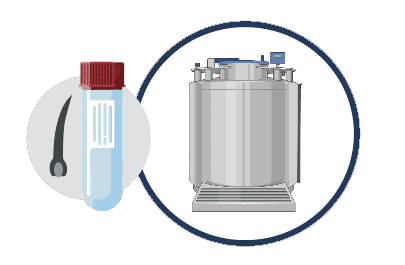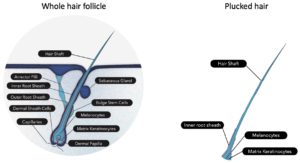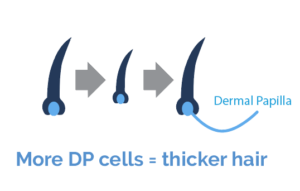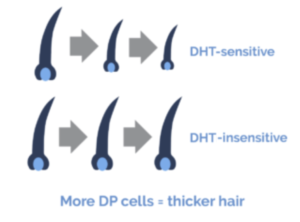Follicle banking involves surgically extracting around 100-120 hair follicles at a HairClone partner clinic (list of clinics below).
Follicles are sent to HairClone and cryopreserved at temperatures so low that cells enter ‘suspended animation’ and do not age.
Follicles remain the property of the patient and can be requested at any time for HairClone’s cell therapy or other potential treatments.
A single banking procedure provides enough follicles for multiple treatments.

Why Bank Now?
Hair cell quality and number decrease with age. Banking early ‘stops the clock’ and retains high cell activity.
Those with banked follicles will be first in line for HairClone’s personalised cell therapy as soon as regulatory approval is obtained.
Banking provides early revenue to HairClone in order to accelerate bringing our revolutionary treatment to the clinic.
How Do I Bank Follicles?
Follicles can only be banked at HairClone’s partner clinics that have been trained and licensed as procurement centres. Please see the list below for locations of our clinical partners.
UK Clinics
- Farjo Hair Institute, Manchester (Drs Bessam and Nilofer Farjo). Call 0333 370 4004
USA Clinics
- California Hair Surgeon, Walnut Creek, CA (Dr Sara Wasserbauer). Call 925 939 4763
- Leonard Hair Transplant Associates, Boston, New Hampshire, RI (Dr Matt Lopresti) Call 800 543 0660
- The Hair Centre, Charlotte, NC (Dr Jerry Cooley) Call 704 368 4870
- Foundation for Hair Restoration, Miami, FL (Dr Jeffrey Epstein) Call 305 666 1774
- The Physicians’ Hair Restoration Centre, Houston, TX (Dr Carlos Puig) Call 713 974 1808
- Anderson Center for Hair, Atlanta, GA (Dr Ken Anderson) Call 404 256 4247
- Bernstein Medical, New York, NY (Dr Robert Bernstein, Dr Christine Shaver) Call 212 826 2400
- Orange County Hair Restoration, Irvine, CA (Dr Ken Williams) Call 949 619 6724
- Hair Sciences Centre of Colorado, Denver, CO (Dr James Harris) Call 303 586 6239
- Tempus Hair Restoration, Central Florida, FL (Marco Barusco) 877 877 5200
Latin American Clinics
- Schambach Hair Clinic, Guatemala City, Guatemala (Dr Marie Schambach). Call +502 2258 9317
Canadian Clinics
- Sure Hair International, Toronto (Dr Aditya Gupta) Call 416 747 7873
Australian Clinics
- The Knudsen Clinic, Sydney, Melbourne, Brisbane, Canberra (Dr Russel Knudsen) Call 02 9327 0300
New Zealand Clinics
- The Knudsen Clinic, Aukland (Dr Russel Knudsen) Call 0800 424 728
Swiss-French Clinics
- Clinique de la croix d’Or, Geneva and My Hair Medical, Lyon (Dr Raphaël Meyer), Call +41 22 736 50 50
Frequently asked questions
What is a hair follicle?
A hair follicle is often considered a ‘miniature organ’ that contains around 20 different cell types, including dermal papilla cells, epithelial bulge stem cells and melanocytes (pigment-producing cells), among many others.
This differs from a plucked hair, which only contains the hair shaft with a limited number of cells attached, in much smaller quantities. Most hair follicle cells remain in the scalp, which is why hairs can regrow when plucked.
To extract a whole hair follicle with its plethora of cell types involves surgical extraction, which can be done in a simple procedure with a hair transplant surgeon. This removes all regenerative cells and the hair will not regrow in this spot.

What is hair loss?
HairClone is focussed on the most common form of hair loss, androgenic alopecia, also known as male/female pattern balding. This occurs when the number of cells within the follicles’ dermal papilla are gradually lost over time. The number of dermal papilla cells directly controls how thick hair is, therefore fewer cells result in thinner hairs.
Hairs are not actually lost during the progression of pattern balding, but they become increasingly thinner, giving the illusion of lost hair.

What is hair rejuvenation?
Hair rejuvenation refers to rebuilding hair follicles. HairClone’s cell therapy aims to rebuild hair follicles by replacing dermal papilla cells that are lost over time.
What is Cryopreservation?
Cryopreservation at HairClone is a process using proprietary technology to cool follicles to very low temperatures (as low as -196 °C). Any chemical activity in the follicle cells is effectively stopped and cells enter a state of ‘suspended animation’. Follicles can be stored for many years and when appropriately thawed, their cells resume normal function.
What are Dermal Papilla Cells?
http://www.ncbi.nlm.nih.gov/pmc/articles/PMC3115771/

What is the difference between a Clinical & Banking Partner and a Banking Partner?
When will hair treatments be available?
HairClone plans to begin clinical work in 2025. The goal is to optimise the clinical process and find the most effective treatment method. Based on results, patients could travel to receive the treatment prior to clinical trials.
Results of this clinical work will be used to inform a multi-centre, international clinical trial, in collaboration with our Clinical Partners, with the aim of eventually offering treatments worldwide.
We will do our utmost with the financial resources available to offer this therapy as quickly and efficiently as possible.
How much will treatment cost?
At this point, we are unable to give exact figures; however, we anticipate costs to be competitive with hair transplants.
Does HairClone's research involve animal testing?
No! Many scientific advancements have been made through the use of animal studies; however, human hair is unique and cannot be readily modelled in animals. HairClone use human tissue and advanced omics techniques to translate laboratory findings directly into the clinic. This approach precludes the need to demonstrate efficacy in animal studies.
Will treated hairs continue to miniaturise?
DHT is a leading cause of hair loss due to initiating cell loss in susceptible follicles. HairClone’s treatment takes dermal papilla cells from follicles that are insensitive to DHT and multiplies them. When injected into thinning areas, miniaturising follicles will be rebuilt using cells that retain their original genetics and remain non-responsive to DHT, providing a long-term effect.

It is likely that treatment will need repeating every 2-3 years if or when new areas begin to lose DP cells and miniaturise.
